Reviews
Alfred L. Werker and Anthony Mann
USA, 1948
Credits
Review by Cullen Gallagher
Posted on 24 January 2013
Source Video Treasures VHS
Categories Noir Mann
He Walked by Night, along with Detour and Gun Crazy, is one of the premier prizes from Hollywood’s Poverty Row. It disinherits so much about the crime genre that had come before it, bucking tradition and disobeying convention, and in the process breaking radical new ground. As much a revolution as it is a revelation, it gets away with things that major studio productions never could have.
He Walked By Night is often credited alongside Jules Dassin’s The Naked City, released earlier that same year in 1948, with introducing documentary aesthetics to the Hollywood crime film. True, they both share certain elements in common: both are shot on-location in their respective geographic areas (The Naked City in New York and He Walked By Night in Los Angeles), and both feature stories about police tracking a killer. But their similarities are not so interesting, or informative, as their differences. The Naked City, for all its innovations, still plays by many of the mystery genre’s rules: it has clearly defined heroes and villains, the heroes have personal lives, the villains have motivations, and there’s meaning to crime and an urgency to solve it. Throughout, the audience is emotionally involved, and the film culminates in a climactic and cathartic gunfight that reinforces the action heroism of its characters and their victory. Not so with He Walked By Night; it breaks all the rules.
After a narrator introduces the city of Los Angeles to us, the story picks up in media res as Roy is attempting to pick the lock of a radio shop on a dark, nearly deserted street. The only other person on the street that evening is a police officer on his way home. When he stops to question Roy, the burglar shoots the cop, escaping back into the night from which he emerged. Whatever narrative Roy and the police officer were independently engaged in has stopped, and a new narrative has formed: a manhunt for Roy. Much of the rest of the story is centered on the mundane, procedural details as the police exercise all their methods for capturing Roy.
One of the many ways He Walked By Night distinguishes itself is in the atypical way it utilizes characters. Foremost, there is no single hero. No protagonist with whom we identify and invest ourselves in. Sure, there are detectives, investigators, forensics specialists, printers, secretaries stuffing and licking envelopes, many of whom recur throughout the narrative, and all of whom contribute to the capture of Roy, yet none of them are heroes in the conventional sense. None of them exercise individualism, none of them single themselves out through acts of daring, and none of them are given any backstory or psychology to make us care for them as humans. Instead, they are abstract cogs in the wheels of police work. If anything, the police force as a mechanical whole is the hero of the film—yet it still lacks the emotional resonance and moral imperative that a hero must have, as well as the classical challenges that must be overcome to achieve hero status. This police department endures no journey, and therefore I don’t think can be counted as a hero.
Another atypical aspect to He Walked By Night’s characters is its killer: Roy. Chillingly portrayed by Richard Basehart, he’s so different from the breed of murderers that have come before him. He plays a psychopath with such subtlety and conviction that is years ahead of his time. He hardly speaks a line of dialogue throughout much of the film, yet he wordlessly conveys such depth of character. Consider his actions after shooting the cop. Roy stands before a mirror shaving. He listens to a radio announcer describing his face as having a mustache. Since he has just shaved it off, he smiles to himself, amused with his own cleverness. An off-screen narrator says:
This was no frightened fugitive. What went on in his mind? Why had he set his hand against his fellow man? Taken the life of another? Of a Stranger? Of a man who was merely doing his duty? He must have some plan, some goal that called for sudden death to anyone who got in his way.
Roy exits the bathroom and feeds his dog, which is not a humane gesture, but one of unsettling calmness and normality.
Later, after sustaining a bullet would during a shoot-out with the police, Roy would return to the mirror. As he as he cuts out the bullet and sews himself up, he is filmed with a close-up on his sweaty face and pained grimace. There’s something uncannily sexual about his bare chest and his physical familiarity with himself, as well as the orgasmic the way he grunts from pain and smiles slightly with satisfaction at the way he manipulates his own body.
For all of Roy’s perverse and psychotic tendencies, he remains little more than an enigma, no more and no less filled out than the detectives. The motivations behind his crimes, his background, his story—we get none of it. As the narrator tells us, “No one in the underworld recognized that mysterious face. He was as unknown as if he lived in the 16th century.” He’s not a gangster, not a career criminal, not a juvenile delinquent, not a repeat offender, not the victim of circumstance, not—not anything. This is yet another way that He Walked By Night breaks with tradition: it denies us even a villain. If there’s no meaning to the crime, does that mean it was even a crime? And can the offender still be classified a criminal? Whereas earlier screen criminals were mostly rooted in melodrama, social realism, or generic necessity, Roy is a whole new breed of existential characterization. Both he and the police are presented as detached, unemotional, even pathological abstractions. They exist only in and of their actions.
Both visually and narratively, He Walked By Night is all about design. The linking of the concepts is the authorial stamp of its uncredited director, Anthony Mann. (Mann took over directing duties from Alfred Werker, however only Werker received any on-screen credit.) In terms of plot, it is manifested as the on-going tension between two conflicting designs: the police dragnet and the criminal strategies of Roy. But without any explicit hero or villain, or any social or emotional context to ground them, He Walked By Night’s story transforms into an almost metaphysical narrative. Genre is abstracted, its elements turned into pure action and vision, and the human and emotional components alienated. Visually, Mann demonstrates this in the geometric re-distribution of space through illumination and shadow and the dramatic counterpoint of black and white. The corporeal violence of guns and fists is transcended by a more theoretical violence of a purely cinematographic kind. Anti-luminous, Mann stages his action in nihilistic cinematic spaces. People fluidly disintegrate into darkness, only to re-materialize in light. Shootouts occur in rooms so dark we can barely discern the bodies or their weapons; they are like shadow monsters fighting in their own shadowy realm. These two arenas - the visual and the narrative - culminate in one of the most arresting finales in all of crime film history in which the police chase Roy through the Los Angeles sewer system. With only the occasional wisp of a flashlight to illuminate the space, Roy is running for his life. He knows that when the light finds him, he will be dead. He is only safe in the blackness. It’s the ultimate fight of light vs. shadow—and the purest expression of Mann’s theoretical, aesthetic, and narrative sensibilities, all of them exploding in one magnificent, atmospheric, and utterly violent climax.
More Noir Mann
-
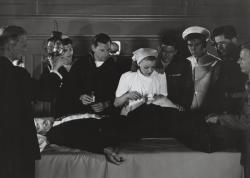
Strangers in the Night
1944 -
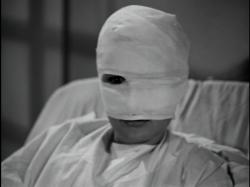
Strange Impersonation
1946 -
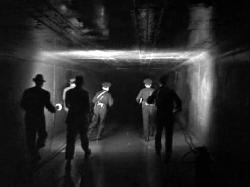
He Walked By Night
1948 -
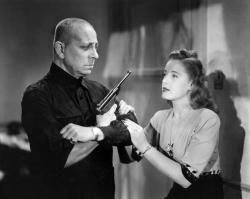
The Great Flamarion
1945 -
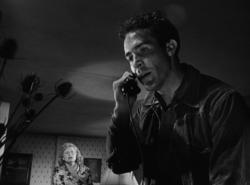
Border Incident
1949 -
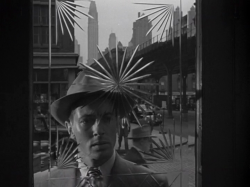
Side Street
1950 -
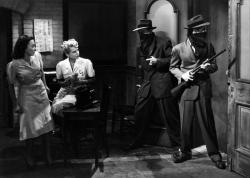
Railroaded
1947
We don’t do comments anymore, but you may contact us here or find us on Twitter or Facebook.



